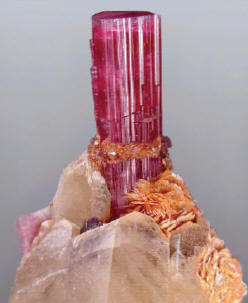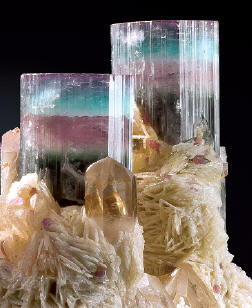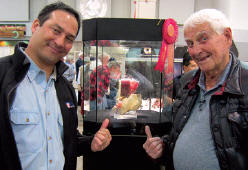both very similar - about 20 cm long matrixof quartz, lepidolite and cleavelanditewith morganite crystal andmulti-color tourmalines with pink, greenand blue zones. All these pockets werefound in the small area of the old supportingpillar. A short time after the carefulextraction of the content of allpockets and cleaning the area the minewas again closed and remains closed tothis day (2012).

10 cm tall tourmaline on quartz collected as one of the last specimens before mine closed in 2001. Swoboda specimen.

Close-up of the six-pack specimen shown on page 5. J. Budd photo.
The mine has not been active in recentyears for several reasons, one of theproblems being the legal issues with PalaIndian Reservation on the territory ofwhich the Tourmaline Queen Mine is located.
The mine is not active but its fameis still alive. In 2006 Bryan Swoboda, sonof Edward, established a company called“BlueCap Productions”. It producesDVDs about minerals and collecting. Thehistory symbolically closed in 2012 whenBryan produced a DVD with his father'spresentation about his gemstone andmineral-dedicated life.
ACKNOWLEDGEMENTS
This article would have never beenwritten if not for the huge help and a lotof information and materials from Edwardand Bryan Swoboda and William From the end of ‘70s to the mid-‘90sthe mine was leased from time to timefor short periods and small-scale operationswere done. The only importantpocket found in this period was the socalled“Six-Pack Pocket” named after the20 cm long specimen of feldspar andquartz with 6 multicolor (blue, purple,pink and green) zoned tourmaline crys-tals on top (see photo on page 5). A secondmajor specimen from that find containstwo colorful tourmalines on quartzcrystals – it is altogether 13 cm tall (seephoto on the cover). The pocket was kepta secret until 2012 and still remains amystery but probably it did not producedmany high quality specimens apart fromthe two described above.
In 1993 the mine was leased toRoland Reed who did not have much luckand after drifting tens of meters of tunnels found only a few small pockets withrubellites. He gave up in 1996.

Edward Swoboda (right) and his son Bryan with “The Rabbit Ears” - one of the most famous specimens from the “bluecap” pocket. Mae L. Swoboda photo.

Recent photo of the Edward Swoboda at the site of the “blue-cap” pocket, owner of the Tourmaline Queen Mine from 1968. B. Swoboda photo.
In 1996 Edward Swoboda decided togive the mine another chance. He rebuiltthe entrance to the mine, created a cookshack with a covered eating area andarranged a “bedroom” along the old tunnelproviding fresh air and guaranteeinga nice temperature all year long. Theminers also placed a statue of SaintGuadalupe surrounded by candles in asmall alcove in the weathered granite.
The mining started again.
In 1997 the mine was explored byCanadian geologists with geo-radar insearch of anomalies. They identified sixanomalies in 2 days. After examiningthem it turned out that they were onlymud filled cracks and vein disturbances- no pockets were found.
Swoboda was a close friend of thefamous gemmologist Richard Liddicoat(after whom liddicoatite was named) forover 40 years. At the end of the ‘90s theyformed a hand-shake agreement to workthe mine pushing a tunnel to reach anenriched zone that Edward believed existedand had never been touched. For alittle less than two years they worked onreaching this area but eventuallystopped the operation as it was gettingexpensive and there was nothing to showfor the work.
In July 2001 Swoboda, together withSan Diego Mining Company, decided towork some surficial parts of the pegmatite.
During this time the vein was exposedon quite a long distance. In theweathered pegmatite there were stillsolid boulders which needed to be removed.
Old tunnels mined back in theearly 1900s were uncovered. A pocketfrom which several cats-eye indicoliteswere recovered was discovered veryclose to one of the tunnels. To continuethe research 1 to 2 tons of heavy bouldershad to be removed. Behind one ofthe boulders a small pocket with 4 cmlong deep blue tourmalines was found.
Soon another pocket was discovered producingtwo superb specimens. They are both very similar - about 20 cm long matrixof quartz, lepidolite and cleavelanditewith morganite crystal andmulti-color tourmalines with pink, greenand blue zones. All these pockets werefound in the small area of the old supportingpillar. A short time after the carefulextraction of the content of allpockets and cleaning the area the minewas again closed and remains closed tothis day (2012).

For the first time since 1972 a big group of the “blue-cap” tourmalines “met” together in 2008 at the Tucson Gem and Mineral Show at the American Mineral Treasures Exhibition. W. Wilson photo.
The mine has not been active in recentyears for several reasons, one of theproblems being the legal issues with PalaIndian Reservation on the territory ofwhich the Tourmaline Queen Mine is located.
The mine is not active but its fameis still alive. In 2006 Bryan Swoboda, sonof Edward, established a company called“BlueCap Productions”. It producesDVDs about minerals and collecting. Thehistory symbolically closed in 2012 whenBryan produced a DVD with his father'spresentation about his gemstone andmineral-dedicated life.
ACKNOWLEDGEMENTSThis article would have never beenwritten if not for the huge help and a lotof information and materials from Edwardand Bryan Swoboda and WilliamLarson. I would like to give my specialthanks to Robert Lavinsky, Wendell Wilson,Scott Richie and Mark Mauthner. Iwould also like to thank other peoplewho helped me with this article in differentways: Jamie Newman, Daniel Trinchillo,Jesse Fisher, Mia Dixon, JamesElliott, Robert Simonoff and Paul Cragan.
To those who would like to readmore about the Tourmaline Queen MineI recommend the California Pegmatitesissue of the Mineralogical Record, 2002,33/5 and literature cited there.
More informationcan also be found atmindat.org: http://www.mindat.org/loc-3564.html







 YueGongAnBei 44051102000467
YueGongAnBei 44051102000467


 |
|